 |
Nádasdy-vár
Sárvár, Hungary
|
|
 |
Constructed: 1549-1562
Used by: Nádasdy family, France and various Hungarian noble families
Conflicts in which it participated:
Rákóczi War of Independence
Also known as:
Castle of Sárvár
|
Hungary became a definable state in the late 9th century, after Hungarian Grand Prince Árpád (845-907) conquered the Carpathian Basin. This was a huge swath of land in Central Europe, which had previously been ruled by a variety of folks: The disparate Hungarian peoples were now united, and they had a big ole place to call their own. |
 |
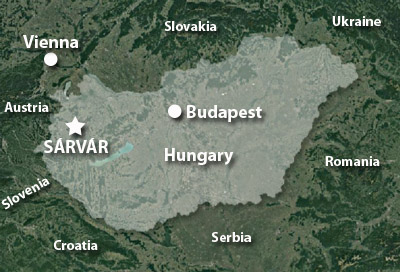 |
|
The Mongols invaded in 1241-1242, a process which killed off up to half of Hungary's population. Wishing to forestall similar events in the future, Hungary's King Béla IV (1206-1270) oversaw the construction of hundreds of stone forts and castles at strategic locations throughout the country. When the Mongols returned in 1285, Hungary's new forts and vast army of heavily-armed knights successfully repelled them. Wow, independent verification that fortification actually works!!
In 1327, a three-story "dwelling tower" was built in the little western Hungarian town of Sárvár, for Hungary's King Charles I (1288-1342). The town got its name from an ancient fortification: Sár is the Hungarian word for "mud," and vár the word for "castle." One imagines that keeping the floors clean in a mud castle is an absolute nightmare. This royal living space was the kernel around which would later pop Nádadsy-vár.
|
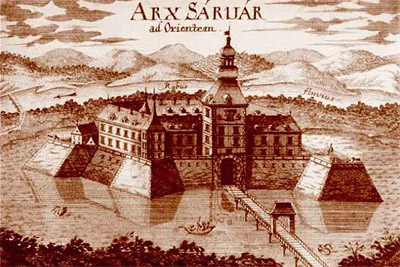 Arx Sárvár ad Orientaen by Matthias Greischer. Pretty, shiny moat! Arx Sárvár ad Orientaen by Matthias Greischer. Pretty, shiny moat! |
 |
Aristocratic families came and went in Sárvár, but the Nádasdy family, whence the starfort of our current interest got its name, proved to be the most amenable to a starfort solution. Támas Nádasdy (1498-1562) married his way into the proper family so as to exert his control in Sárvár by the mid-16th century, and 'twas he we can thank for its starfort upgrade.
Italian engineers were recognized as the world class in starfort design in the early days of starfortery, which included the period in question here. Skilled Italians were thus enticed to Sárvár, where they worked their starfort magic. The completed Nádasdy-vár had five bastions, and was surrounded by wetlands. |
|
|
In addition to securing the city with a starfort, Támas founded Sárvár's first school, and dragged a printing press all the way from Germany, which he installed in Nádasdy-vár. The first book printed in Hungary (a Hungarian translation of the New Testament) was produced on that press, in our starfort.
|
As awesome a dude as Támas was, he wasn't the coolest Nádasdy male to inhabit his eponymous starfort: That cherished title would have to go to his son, Ferenc Nádasdy (1555-1604). A leader of men, Ferenc developed quite a reputation amongst the Ottoman Turks, who by this period were doing their darndest to consume all of Europe...with particular violent attention being paid to Hungary.
Ferenc was known for cleverness and ferocity in battle, and was saddled with a nickname by his admiring enemies. Fortunately, this nickname appears today in many entertaining translations: "Black Bitch," "Black Bug," "Baa Black," "The Strong Black Turtle" and "The Strong Black Turmoil" are the first five *I* came across. Whether he was a turtle, bug or bitch, everyone seemed to be able to agree upon the black part, although one imagines that he was a Caucasian. Go figure! Turks were the folks coming up with these nicknames, and a Turk will do what a Turk will do.
|
 |
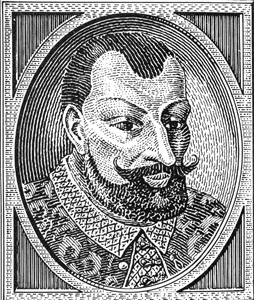 Ferenc Nádasdy: Black Turtle of Turmoil. Ferenc Nádasdy: Black Turtle of Turmoil. |
|
Even before Mr. Bug of Blackness was born, Hungary had been so damaged by Ottoman incursion that it had been split into three sections. The northwestern part, in which Sárvár was situated, was free of Turks but in 1526 was claimed by those other greedy persons, the Austrian Habsburgs. As if all of this weren't dislocating enough for Hungarian society, the Protestant Reformation was brewing through the 15th and 16th centuries, which put most of Hungary's population at odds with the ruling Habsburgs: Many Protestants felt that the Counter-Reformation, a Habsburgian scheme to un-Protestantize Hungary, was a bigger threat than the Turks.
Ferenc returned to his starfort in 1603, and died "suddenly" in 1604. His wife, Erzsébet Báthori (1560-1614), lived as a widow in Nádasdy-vár until 1610, when Sárvár's mayor, one György Thurzó (1567-1616) tromped onto the scene, arrested her, and confiscated her starfort.
|
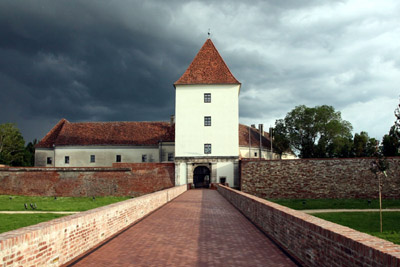 Nádasdy-vár's northern gate, under stormy skies. Is this the three-story dwelling tower that was the first part of this starfort? Why am I asking you? |
 |
Ferenc and Erzsébet reputedly dabbled in "black magic," possibly as a means of remaining forever youthful. All of the mirrors in Nádasdy-vár were supposedly smashed (since not seeing oneself automatically makes one young and attractive), and numerous servant girls were reportedly tortured and/or killed, their virginal blood utilized for various unholy purposes. But to be fair, a dead servant girl doesn't really need her blood any longer, now does she.
Erzsébet was accused of the murder of "hundreds" of servants...which seems unlikely. This was an age of witch accusation and trials, however, and it is quite possible that mayor Thurzó just made a bunch of stuff up about her because he wanted her starfort. |
|
|
Whatever the truth of the situation, Erzsébet was found guilty of various nefarious things and imprisoned for the rest of her life: She died and/or was murdered in 1610. Nádasdy-vár was held by the notionally scheming mayor until he passed away, in 1616...whereupon it appears that the Nádasdy family somehow reacquired their starfort! Another Ferenc Nádasdy (1623-1671), a county judge, amassed great wealth in the mid-17th century and used substantial portions of it to prettify Nádasty-vár's interior.
|
Ferenc III (El Strong Black Turtle, Ferenc III's great grandfather, had been Ferenc II) constructed our fort's Ornamental Hall, and completed a series of frescoes on that hall's ceilings in 1653. Yes sir, one sure can spruce up a starfort that is never ever expected to repel any sort of attacker, can't one?
Unfortunately, in addition to being fabulously wealthy, the Rich Gray Buckle (a nickname I just invented, but which the Turks surely would have called Ferenc III had they known of him) also plotted against the Habsburgs, to his ultimate disadvantage...and his ultimate beheading, which can be pretty disadvantageous.
|
 |
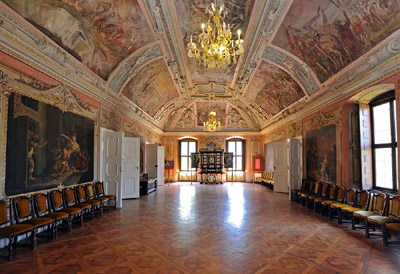 One of Nádasdy-vár's ridiculously ornate rooms. Frescoes on the ceiling of a starfort? Sacrilege. One of Nádasdy-vár's ridiculously ornate rooms. Frescoes on the ceiling of a starfort? Sacrilege. |
|
The Wesselényi (Magnate) Conspiracy pitted mid-level Hungarian and Croatian nobles against the ruling Habsburgs. Unhappy with the way the Habsburgs were running things, the conspirators managed some riotous uprisings, but were inevitably crushed in the standard Habsburgian manner. Ferenc III, one of the top dogs of the conspiracy, was executed on April 30, 1671, in Vienna. His many properties were confiscated, and the town of Sárvár, along with its starfort, was purloined by Miklós Draskovich, of the wicked-sounding-but-probably-no-wickeder-than-anybody-else-at-the-time noble Draskovich family.
|
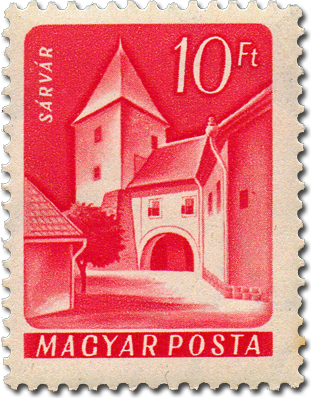 A ten-forint Hungarian stamp from 1960: Yep, that's Nádasdy-vár! |
 |
Another guy named Ferenc affected Nádasdy-vár at the start of the 18th century. Ferenc Rákóczi (1676-1735), a Hungarian noble, was (surprise!) displeased with Habsburg rule and wished for an independent Hungary. Ferenc composed a pro-independence manifesto in 1703, which sparked the Rákóczi War of Independence, a conflict that ran from 1704 until 1711. At some point during this war, "rebels," which one assumes means independence-seeking Hungarians, captured and held Nádasdy-vár for a brief period. They must have tiptoed about the sumptuous interior of the starfort of our current interest very carefully, as just about all of it is still intact today.
Rákóczi's war was unsuccessful, but he did okay for himself afterwards, traipsing around Poland, France and England, eventually settling in Turkey of all places. The Turks approached him and offered to put him at the head of a Christian army to fight the Austrians on behalf of Hungary (surely the Ottomans wouldn't have expected any Hungarian land in exchange for this), but Ferenc declined, and spent the rest of his days attending mass and building furniture in a small Hungarian settlement on the Sea of Marmara. |
|
|
The only other power to have held Nádasdy-vár appears to have been the French. I find no specific mention of them in the fort, but the city of Sárvár was held from June until November of 1809 by the French in their Napoleonic mode, and it seems likely that some French officer or other would have hung his chapeau in such lush surroundings!
Through the rest of the 18th and into the 19th century, Nádasdy-vár was owned by a variety of well-financed sort of folks of European nobility, many of whom added to the fort's grandeur. A major overhaul of the fort occurred in 1720, and in 1803 it was acquired by the Esteya family of Modena, Italy. During their tenure, the fort's moat was filled and its interior structures rebuilt "in the classicist style." The Wittelsbachs, a Bavarian noble family, owned Nádasdy-vár until 1945.
The history of Nádasdy-vár has more to do with culture than war. Built, owned and maintained by noble families instead of governments (although noble families in Europe at the time really were the government) and designed for fancy livin' more than desperate defendin', it stands out in the world of starforts as a shiny, gilt-edged jewel. Today it is the home to several cultural enterprises, including a library and a museum. Much of that museum is given over to celebrating the Black Bug, Ferenc Nádasdy II...it would be difficult to do otherwise, as many of the beautiful frescoes on the walls and ceilings of the fort's interior buildings celebrate his military victories!
|
|
|
|
|
|
 |




